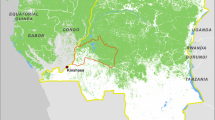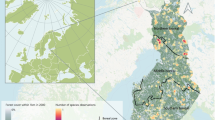Abstract
For the protection of forest-interior species in both natural forest islands and anthropogenic forest fragments knowledge on the size of forest-core areas is a central issue. In an intact mosaic of semi-deciduous forests and savanna in the Comoé National Park 31 forest islands were selected (2.1–146.1 ha). Values for the depth-of-edge influence (DEI) of the study area recently published range from 0 m up to nearly 150 m. Thus, core-area analysis was carried out for this range in 5 m steps. For a DEI of 55 m—e.g. computed for tree-species composition of large trees—half of the total forest area can be considered as core area, but only 9 of the studied forest islands still contained a relative core area (rCA) of more than 50%. From non-linear regression it was estimated that for a DEI of 55 m an rCA of 50% can be expected for forest islands with a size of 36.6 ± 7.6 ha. This value increased exponentially with increasing DEI. The GIS-based core-area analysis presented in this paper proved to be suitable to give a well interpretable overview on rCA with respect to varying DEI, and we recommend to incorporate this type of analysis in existing GIS-tools. As the presented study is the first sound core area analysis at forest islands in West Africa, data contribute to a better understanding of this field of ecology that is of high relevance for planners and decision makers to protect biodiversity.




Similar content being viewed by others
Abbreviations
- CA :
-
Core area
- CNP:
-
Comoé National Park
- DEI:
-
Depth-of-edge influence
- OrCA :
-
Overall relative core area
- rCA :
-
Relative Core area
- TA :
-
Total area
References
Achard F, Eva HD, Stibig HJ et al (2002) Determination of deforestation rates of the world’s humid tropical forests. Science 297:999–1002
Bates DM, Watts DG (1988) Nonlinear regression analysis and its applications. Wiley series in probability and mathematical statistics. Wiley, New York
Brooks T, Balmford A, Burgess N et al (2001) Toward a blueprint for conservation in Africa. Bioscience 51:613–624
Cantrell RS, Cosner C, Fagan WF (2001) How predator incursions affect critical patch size: the role of the functional response. Am Nat 158:368–375
Cayuela L, Golicher DJ, Rey Benayas JM et al (2006) Fragmentation, disturbance and tree diversity conservation in tropical montane forests. J Appl Ecol 43:1172–1181
Cochrane MA, Laurance WF (2002) Fire as a large-scale edge effect in Amazonian forests. J Trop Ecol 18:311-325
Curran LM, Trigg SN, McDonald AK et al (2004) Lowland forest loss in protected areas of Indonesian Borneo. Science 303:1000–1003
Didham RK, Lawton JH (1999) Edge structure determines the magnitude of changes in microclimate and vegetation structure in tropical forest fragments. Biotropica 31:17–30
Drake DR, Mulder CPH, Towns DR et al (2002) The biology of insularity: an introduction. J Biogeogr 29:563–569
Fahrig L (2003) Effects of habitat fragmentation on biodiversity. Annu Rev Ecol Evol Syst 34:487–515
Fearnside PM, Laurance WF (2003) Comment on “Determination of deforestation rates of the world’s humid tropical forests”. Science 299:1015a
Fernandez C, Acosta FJ, Abella G et al (2002). Complex edge effect fields as additive processes in patches of ecological systems. Ecol Model 149:273–283
FGU-Kronberg (1979) Gegenwärtiger Status der Comoé- und Taï-Nationalparks sowie des Azagny-Reservats und Vorschläge zu deren Erhaltung und Entwicklung zur Förderung des Tourismus. II. Comoé-Nationalpark. 1. Bestandsaufnahme der ökologischen und biologischen Verhältnisse. GTZ GmbH, Eschborn
Fischer F, Linsenmair KE (2001). Decreases in ungulate population densities. Examples from the Comoé National Park, Ivory Coast. Biol Conserv 101:131–135
Fischer F, Gross M, Linsenmair KE (2002) Updated list of the larger mammals of the Comoé National Park, Ivory Coast. Mammalia 66:83–92
Gascon C, Williamson GB, Da Fonseca GAB (2000) Receding forest edges and vanishing reserves. Science 288:1356–1358
Goetze D, Hörsch B, Porembski S (2006) Dynamics of forest-savanna mosaics in north-eastern Ivory Coast from 1954 to 2002. J Biogeogr 33:653–664
Guillaumet JL, Adjanohoun E (1971) La végétation de la Côte d’Ivoire. In: Le Milieu Naturel de la Côte d’Ivoire. Orstom, Paris, pp 161–262
Hennenberg KJ (2005) Vegetation ecology of forest-savanna ecotones in the Comoé National Park (Ivory Coast): border and ecotone detection, core-area analysis, and ecotone dynamics. Dissertation, University of Rostock
Hennenberg KJ, Goetze D, Kouamé LK et al (2005) Border and ecotone detection by vegetation composition along forest-savanna transects in Ivory Coast. J Veg Sci 16:301–310
Hennenberg KJ, Fischer F, Kouadio K et al (2006) Phytomass and fire occurrence along forest-savanna transects in the Comoé National Park, Ivory Coast. J Trop Ecol 22:303–311
Hennenberg KJ, Goetze D, Szarzynski J Detection of seasonal variability in microclimatic borders and ecotones between forest and savanna. Basic Appl Ecol, in press
Hovestadt T, Yao P, Linsenmair KE (1999) Seed dispersal mechanisms and the vegetation of forest islands in a West African forest-savanna mosaic (Comoé National Park, Ivory Coast). Plant Ecol 144:1–25
Jenkins MA, Parker GR (2000) Changes in the forest landscape of the Charles C. Deam wilderness, southern Indiana, 1939–1990. Nat Area J 20:46–55
Küper W, Sommer JH, Lovett JC et al (2004) African hotspots of biodiversity redefined. Ann Mo Bot Gar 91:525–535
Laurance WF, Yensen E (1991) Predicting the impacts of edge effects in fragmented habitats. Biol Conserv 55:77–92
Laurance WF, Ferreira LV, Rankin-de Merona JM et al (1998) Rain forest fragmentation and the dynamics of Amazonian tree communities. Ecology 79:2032–2040
Laurance WF, Albernaz AKM, Da Costa C (2001) Is deforestation accelerating in the Brazilian Amazon? Environ Conserv 28:305–311
Lehmann EL (1999) Theory of point estimation, 2nd edn. Springer, New York
Lomolino MV, Weiser MD (2001) Towards a more general species-area relationship: diversity on all islands, great and small. J Biogeogr 28:431–445
MacArthur RH, Wilson EO (1967) The theory of island biogeography. Princeton University Press, Princeton
Malcolm JR (1994) Edge effects in central Amazonian forest fragments. Ecology 75:2438–2445
Murcia C (1995) Edge effects in fragmented forests: implications for conservation. Trends Ecol Evol 10:58–62
Myers N, Mittermeier RA, Mittermeier CG et al (2000) Biodiversity hotspots for conservation priorities. Nature 403:853–858
Poilecot P, Bonfou K, Dosso H et al (1991) Un écosystème de savane soudanienne: Le Parc National de la Comoé (Côte d’Ivoire). Project UNESCO/PNUD n° IVC/87/007, not technique 2, UNESCO, Paris
Putz FE, Blate GM, Redford KH et al (2001) Tropical forest management and conservation of biodiversity: an overview. Conserv Biol 15:7–20
Ranta P, Blom T, Niemela J et al (1998) The fragmented Atlantic rain forest of Brazil: size, shape and distribution of forest fragments. Biodivers Conserv 7:385–403
R Development Core Team (2005) R: a language and environment for statistical computing. R Foundation for Statistical Computing, Vienna, Austria. ISBN 3-900051-07-0, URL http://www.R-project.org
Ries L, Fletcher RJ, Battin J et al (2004) Ecological responses to habitat edges: mechanisms, models, and variability explained. Annu Rev Ecol Evol Syst 35:491–522
Russell WH, Jones C (2001) The effects of timber harvesting on the structure and composition of adjacent old-growth coast redwood forest, California, USA. Landscape Ecol 16:731–741
Salzmann U (2000) Are modern savannas degraded forests?—A Holocene pollen record from the Sudanian vegetation zone of NE Nigeria. Veg Hist and Archaeobot 9:1–15
Salzmann U, Hoelzmann P, Morczinek I (2002) Late quaternary climate and vegetation of the Sudanian zone of northeast Nigeria. Quaternary Res 58:73–83
Saunders DA, Hobbs RJ, Margules CR (1991) Biological consequences of ecosystem fragmentation: a review. Conserv Biol 5:18–32
Wassenaar T, Gerber P, Verburg PH et al (2007) Projecting land use changes in the Neotropics: the geography of pasture expansion into forest. Global Environ Chang 17:86–104
White F (1983) The vegetation of Africa. UNESCO, Paris
Wei Y, Hoganson HM (2005) Landscape impacts from valuing core area in national forest planning. Forest Ecol Manage 218:89–106
Zheng DL, Chen JQ (2000) Edge effects in fragmented landscapes: a generic model for delineating area of edge influences (D-AEI). Ecol Model 132:175–190
Acknowledgements
This study is embedded in the BIOTA Africa program (Biodiversity Monitoring Transect Analysis in Africa), funded by the German Federal Ministry of Education and Research (BMBF, project ID: 01 LC 0017/01 LC 0409). The Ivorian Ministry of Eaux et Forêts kindly gave the permission to conduct research in the CNP. We express our gratitude to our Ivorian counterparts at the Universities of Cocody and Abobo-Adjamé, namely D. Traoré and M. Tahoux Touao. We would like to thank K. E. Linsenmair, F. Fischer, and employees of the ‘Projet Biodiversité’ who enabled us to carry out our work in the CNP at the research station of the University of Würzburg. We are especially grateful to our field assistant L. K. Kouamé. Warm thanks to S. Adler, N. Ebigbo, A. Eggert, D. Goetze, T. Hovestadt, A. Koulibaly, and N. Reintjes for their constructive discussion during field work as well as for their valuable comments on this manuscript.
Author information
Authors and Affiliations
Corresponding author
Appendices
Appendices
Appendix 2
Estimation of total area (TA) in dependence on an aspired relative core area (rCA) and derivation of its confidence intervals.
Let rCA and TA denote the relative core area and the total area of forest islands, respectively. For the given data values rCA i and TA i we assume the non-linear regression model
with zero-mean error terms e i and unknown coefficients a and b. By non-linear least squares, the estimates \( \hat{a} \) and \( \hat{b} \) for a and b are determined. The corresponding estimates for their standard deviation and its covariance are denoted by \( S\hat{D}_{a}\), \( S\hat{D}_{b}\), and \( S\hat{D}_{{a,b}} . \) The deterministic functional relationship between TA and rCA from Eq. 1 gives \( TA = TA{\text{(}}rCA{\text{)}} = (rCA \cdot b)/(a - rCA) = f(a,b). \) Therefore, for a given rCA we can estimate TA(rCA) by \( T\hat{A} = f(\hat{a},\hat{b}) = (rCA \cdot \hat{b})/(\hat{a} - rCA). \)
Applying the Delta-Method (see Lehmann 1999) to \( f(\hat{a},\hat{b}) \) we get an estimate for the standard deviation of \( T\hat{A} \) by
Assuming a ‘normal distribution’ for the distribution of \( \hat{a} \) and \( \hat{b}, \)which can be justified for sufficiently large sample sizes, a confidence interval CI for TA(rCA) can be constructed by
where \( z_{{1 - \alpha /2}} \) is the (1−α/2)-quantile of the standard normal distribution.
Rights and permissions
About this article
Cite this article
Hennenberg, K.J., Orthmann, B., Steinke, I. et al. Core area analysis at semi-deciduous forest islands in the Comoé National Park, NE Ivory Coast. Biodivers Conserv 17, 2787–2797 (2008). https://doi.org/10.1007/s10531-007-9292-1
Received:
Accepted:
Published:
Issue Date:
DOI: https://doi.org/10.1007/s10531-007-9292-1




